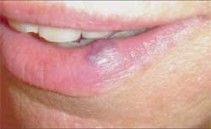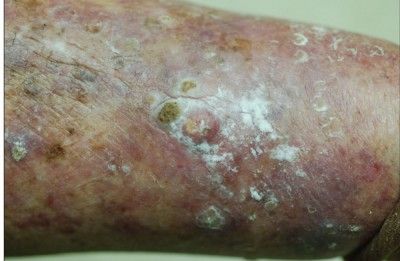7 Reasons Why Summer Sun Might Not Be So Fun
Phototoxicity, venous lakes, polymorphic light eruption, keratoacanthhoma-this photo essay brings common solar scourges into focus.
For many of your patients, summer means fun in the sun. Unfortunately, all that warm-weather activity also means skin in the sun. No matter how faithfully patients follow your sun protection guidance, a variety of skin disorders are bound to surface, along with other seasonal ills spawned by increased outdoor activity.
The 7 short cases that follow focus on common solar scourges you’re likely to see in your office this summer.

1. Phototoxicity Means Drugs and Sun Don’t Mix
• Dose-dependent non–immune-mediated cell damage in the skin with exposure to sunlight may be caused by some medications, as in the phototoxic drug eruption on this boy’s shoulders.
• The cutaneous findings in phototoxic reactions are similar to an exaggerated sunburn-type reaction, with erythema but no edema at sun-exposed sites.
• Phototoxic reactions occur within hours of sun exposure in any patient exposed to sufficiently high doses of the drug and UV light.
• Discontinuation of the offending agent and avoidance of sun exposure are the key aspects of managing phototoxicity.
NEXT CASE »
For the discussion, click here.

2. “Growth in Both Eyes” Seen With UV Light Exposure
• A 45-year-old man of Hispanic ancestry presented with a “growth in both eyes.” He had pterygia, well-defined triangular growths that are thought to be associated with UV light exposure.
• Pterygia usually do not interfere with vision. In most cases, they are of concern to patients and clinicians because of their abnormal appearance and associated irritation and redness.
• Topical lubricants may be used for treatment. If a pterygium affects or threatens to affect the visual axis or if eye movements are restricted, surgical removal is indicated. Eye protection with prescription sunglasses may be the most practical advice for patients at risk.
NEXT CASE »
For the discussion, click here.

3. Is That Venous Lakes, New Jersey?
•Venous lakes, which represent dilated venules, occur on sun-exposed areas, particularly the lips and ears. There may be pain, tenderness, and excessive bleeding.
•Venous lakes often contain thrombi, probably because of chronic solar damage to the skin’s vasculature and ground substance that results in dilatation of superficial venous structures with associated thrombosis.
•The diagnosis usually can be made clinically. Diascopy may differentiate a venous lake from other lesions. A shave biopsy can be performed for definitive diagnosis and removal.
NEXT CASE »
For the discussion, click here.

4. A Rash That’s No Day at the Beach
• This intensely itchy, blistering rash on the forearms and upper chest of a 13-year-old girl occurred after a day at the beach. The girl had polymorphic light eruption (PMLE), the most common abnormal reaction to UV light.
• PMLE classically presents as a papular or papulovesicular eruption on the arms and anterior chest with sparing of the face. Severe involvement of some parts of the body with paradoxical sparing of other similarly exposed areas is a morphological hallmark.
• The reaction usually begins 12 to 24 hours after an initial exposure to light of a suddenly increased intensity. The rash persists for 7 to 10 days and resolves without scarring but may recur with subsequent intense UV light exposure.
NEXT CASE »
For the discussion, click here.

5. Sun-exposed Skin Shows a Squamous Cell Variant
• These slightly tender nodules erupted on the arms and legs of a 75-year-old woman who had extensive sun damage. A skin biopsy revealed them to be the keratoacanthoma type of squamous cell carcinoma.
• This squamous cell carcinoma variant often undergoes spontaneous involution. Eruptive keratoacanthomas of Grzybowski are a generalized distribution of multiple keratoacanthomas that typically do not involute.
• The primary treatment for patients with keratoacanthoma is surgery. Medical therapy is reserved for patients with comorbidities that preclude surgery and for those who have multiple lesions or those that are not amenable to surgical intervention because of size or location.
NEXT CASE »
For the discussion, click here.

6. Is It Sunburn or EGFR Inhibitor UV Sensitivity?
• Increased sensitivity to ultraviolet radiation, manifested as sunburn, may occur when patients are receiving epidermal growth factor receptor inhibitors.
• Applying broad-spectrum sunscreens (containing zinc oxide or titanium dioxide) with a sun protection factor higher than 30 is critical.
• Therapies that target specific pathways or proteins in cancer cells are especially noted for dermatologic events, which affect up to 90% of treated patients.
NEXT CASE »
For the discussion, click here.

7. Connective Tissue Damage Induced by the Sun
• Sun-induced damage to the connective tissue of the dermis may result in solar purpura, particularly in older white men and women.
• The patches and macules of solar purpura usually are purple and irregularly shaped. They often occur on a background of dermatoheliosis (lichenification, stellate white pseudoscars, and sallow skin color).
• The lesions usually are found on the extensor surfaces of the forearms and the dorsa of the hands at sites of minor trauma and may occur on the neck. They typically resolve over 1 to 3 weeks.